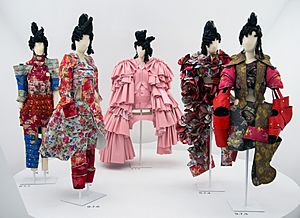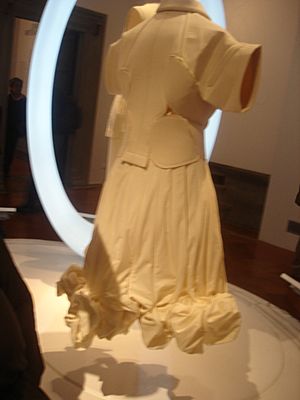Rei Kawakubo facts for kids
Quick facts for kids
Rei Kawakubo
|
|
|---|---|

Rei Kawakubo/Comme des Garçons Art of the In-Between exhibit in 2017
|
|
| Born |
かわくぼ れい
川久保 玲 11 October 1942 Tokyo, Japan
|
| Education | Keio University |
|
Label(s)
|
Comme des Garçons |
| Spouse(s) | Adrian Joffe |
Rei Kawakubo (born October 11, 1942) is a famous Japanese fashion designer. She lives in Tokyo and Paris. She started the fashion brand Comme des Garçons and the store Dover Street Market. In 2017, a special art show about her designs opened at the Metropolitan Museum of Art in Manhattan. It was called Rei Kawakubo/Comme des Garçons Art of the In-Between.
Contents
Early Life and Education
Rei Kawakubo was born in Tokyo, Japan, on October 11, 1942. She was the oldest of three children and the only daughter. Her father worked at Keio University. This university was started by Fukuzawa Yukichi, who supported Western culture and women's rights.
Rei Kawakubo did not study fashion design formally. Instead, she studied fine arts and literature at Keio University. She earned a degree in "the history of aesthetics" in 1964. This included studying art from Asia and the West. After graduating, she worked in advertising for a textile company. Then, in 1967, she became a freelance stylist. Two years later, she began designing and making her own clothes. She called her brand Comme des Garçons, which means "like the boys" in French. She officially started the company in 1973.
Starting a Fashion Brand: 1969–2004
In 1969, Rei Kawakubo started her company, Comme des Garçons, in Tokyo. She opened her first store there in 1975. At first, she only made women's clothes. In 1978, she added a men's clothing line. Three years later, she began showing her fashion collections in Paris during Paris Fashion Week. She opened a store in Paris in 1982.
Comme des Garçons is known for its unique style. It often features clothes that are simple, sometimes taken apart, and go against traditional fashion. By 1980, her company was doing very well. It had many stores across Japan. In the 1980s, her clothes were mostly black, dark grey, or white. Because of this, the Japanese press called Kawakubo and her fans "The Crows." Her designs often had frayed edges, holes, and uneven shapes. When she first showed her clothes in Paris, some journalists called them "Hiroshima chic." This was because her designs challenged common ideas of beauty. Since the late 1980s, she has used more colors.
Kawakubo likes to be involved in all parts of her business. This includes graphic design, advertising, and even how her stores look. She believes everything should fit her overall vision. Her store in Aoyama, Tokyo is famous for its unique glass front with blue dots. She also started her own magazine called 'Six' in the early 1990s. It had mostly pictures and very little text. In 1993, she launched the Comme des Garçons Parfums line. Rei Kawakubo is known for being private and not liking a lot of media attention. She prefers her designs to speak for themselves. She has also supported diverse cultural themes in her advertising campaigns.
Creative Designs and Influence: 2003–2018
Since 2003, other famous designers have often talked about Rei Kawakubo's original ideas. They see her as a big influence in fashion. In interviews broadcast in Japan, designers like Alexander McQueen and Viktor & Rolf praised her work. McQueen said that Kawakubo always challenges herself. Viktor & Rolf remembered being impressed by Comme des Garçons when they were young.
Jean-Paul Gaultier and Donna Karan were also early supporters. Gaultier called Kawakubo a woman with "extreme courage" and a "poetic spirit." Donna Karan described her as quiet but making a huge statement with her clothes.
Kawakubo's designs have inspired many other designers. These include Martin Margiela, Ann Demeulemeester, and Helmut Lang. Comme des Garçons clothes are designed in Tokyo and made in Japan, France, Spain, and Turkey. Her 2006 autumn/winter collection explored the idea of "persona." This means the different ways we show ourselves to the world. It mixed men's tailored clothes with feminine details like corsets.
Designers Junya Watanabe and Tao Kurihara have also started their own successful lines under the Comme des Garçons name. Comme des Garçons has worked with many other brands over the years. These include Fred Perry, Levi's, Converse All Star, Nike, Louis Vuitton, and Supreme. In 2008, Kawakubo designed a special collection for H&M. It included clothes for men, women, and children, plus a perfume.
Rei Kawakubo also created Dover Street Market. This is a unique department store that focuses on visual displays and new designers. It first opened in London in 2004. Now there are locations in Tokyo, Beijing, Singapore, New York, and Los Angeles.
In 2017, Vogue magazine and the Metropolitan Museum of Art in New York held a special exhibition about Kawakubo. It was called "Art of the In-Between." The curator, Andrew Bolton, said that Kawakubo's influence is huge, even if it's subtle. He mentioned that Kawakubo was very involved in designing the exhibit. The show featured about 150 Comme des Garçons outfits. Reviewers praised the exhibition, calling it "overpowering" and showing "the most influential forms from the least compromising genius."
Design Inspiration
Rei Kawakubo is one of fashion's most important designers. She always tries to change how traditional clothes look. She was the second living designer to have an exhibition at the Metropolitan Museum of Art. This show highlighted the main ideas that inspire her designs.
Kawakubo often rethinks the human body in her work. She creates new ideas of beauty by adding unusual shapes and bumps to her clothes. These outfits do not follow standard sizes. For example, her spring/summer 1997 collection was called "Body Meets Dress, Dress Meets Body." In this collection, she explored how clothes can change the body's shape. She made unstructured dresses that did not highlight typical body parts. By doing this, she also questioned ideas about gender. Her fall/winter 2017 collection, called "the future of silhouette," also showed these themes. Even though Kawakubo is a woman, she has said that her gender does not affect her designs. She aims to break free from gender stereotypes in her work.
Legacy
After her 2017 exhibition at the Met, Rei Kawakubo's husband, Adrian Joffe, suggested it might be the last exhibition she would personally be involved in. He mentioned that the exhibition might travel to other museums after it closed in New York on September 4, 2017. However, he did not expect her to create a brand new exhibition on different themes.
Personal Life
In the 1980s and 1990s, Rei Kawakubo was in a relationship with fellow Japanese fashion designer Yohji Yamamoto. Later, she married Adrian Joffe. He is the current CEO of Comme des Garçons and Dover Street Market. Rei Kawakubo lives in Tokyo. She often travels to Paris to visit her company's main offices. She also sometimes attends her fashion shows.
Adrian Joffe joined her company in 1987. He is ten years younger than Kawakubo. They married in 1992 in Paris. They have a unique partnership. While Joffe is based in Paris, Kawakubo lives in Tokyo. She is known for being the first one in the office in the morning and the last to leave at night. When they are together, Joffe often helps her by translating and protecting her from too many questions.
Main Fashion Lines
- Comme des Garçons
- Comme des Garçons Commes des Garçons
- Comme des Garçons Girl
- Comme des Garçons Homme
- Comme des Garçons Homme Plus
- Comme des Garçons Homme Deux
- Comme des Garçons Shirt
- BLACK Commes des Garçons
- PLAY Comme des Garçons
- Comme des Garçons Parfums
- Comme des Garçons Wallet
- Comme des Garçons Play
- Comme des Garçons CDG
See also
 In Spanish: Rei Kawakubo para niños
In Spanish: Rei Kawakubo para niños
- Deconstruction (fashion)
- 1980s in fashion
- 1990s in fashion
- Rei Kawakubo/Comme des Garçons Art of the In-Between


